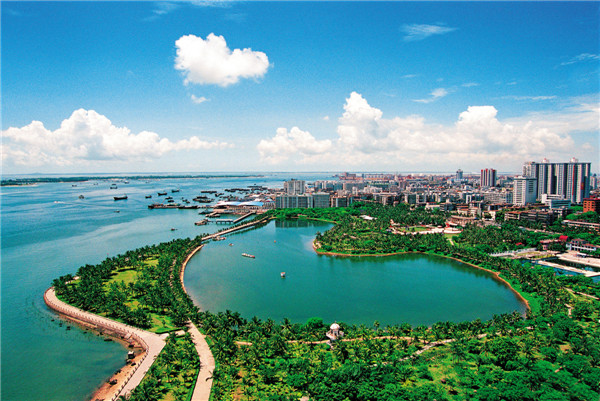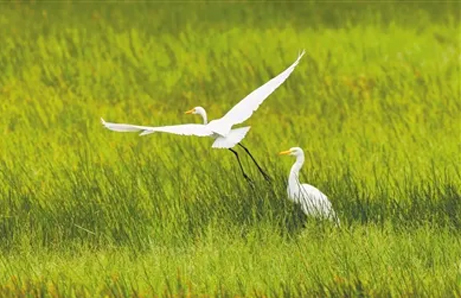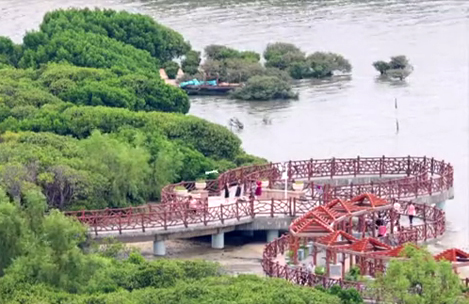Home> Overview
Overview
Location
Zhanjiang city, between 109 degrees 31 minutes - 110 degrees 55 minutes east longitude and 20 degrees 12 minutes - 21 degrees 35 minutes north latitude, is located in the southernmost part of the Chinese mainland and southwest of Guangdong province, covering the northern part of Leizhou Peninsula. Facing Southeast Asia, it is at the juncture of Guangdong province, Guangxi province and Hainan province, with the hinterland of South and Southwest China to the north and the Pacific Ocean to the south. With a registered population of 8.48 million, Zhanjiang consists of three county-level cities (Leizhou, Lianjiang and Wuchuan), two counties (Xuwen county and Suixi county) and four districts (Xiashan district, Chikan district, Potou district and Mazhang district). As it possesses one State-approved economic and technological development zone and six province-approved economic development zones, an all-around opening-up pattern has gradually taken shape.
Climate
Zhanjiang, which is located in the southern low-latitude region of the Tropic of Cancer, enjoys a tropical and subtropical monsoon climate. Regulated by a marine climate all year, it is neither severely cold in winter nor intensively hot in summer. The average annual temperature ranges between 22.7 C and 23.3 C, with mean annual sunshine duration reaching 1,864-2,160 hours and mean annual precipitation running up to 1,417-1,802mm.

Zhanjiang city, Guangdong province [Photo by Mo Guanxing]
Topography
Zhanjiang's land area mainly consists of peninsulas and islands, with an altitude of less than 100 meters. Plains represent 66 percent of the city's total area, while hills account for 30.6 percent and mountainous areas make up 3.4 percent. The highest terrain lies in the northern and northwestern part of Lianjiang city. The highest mountain peak, Shuangfengzhang (380 meters above sea level), and dozens of other mountain peaks with an altitude from 100 to 300 meters form a natural barrier. The hillside peninsula terrace faces the sea on three sides. The slightly undulating platform has no peaks while the terrain is relatively flat. There are many paddy fields, streams and gullies among the slopes of land. The higher lands consist of hills resulting from volcanic eruptions. The higher hills mainly include Luogang Hill (223 meters above sea level), Shili Hill (226 meters above sea level), Shimao Hill (259 meters above sea level) and Shiban Hill (245 meters above sea level).
Tourism resources
With a blue sea, beautiful beaches and coconut trees, Zhanjiang has rich tourism resources. The city has 16 State-level A-class scenic spots by February 2019, including five 4A spots, seven AAA spots and four AA spots, including the world geological park, Huguang Scenic Area of Zhanjiang District of Leiqiong Global Geopark, the historical city of Leizhou, the provincial Donghai Island Longhaitian Tourist Resort, the provincial Wuchuan Jizhaowan Tourist Resort, Nansandao Tourist Resort, Techeng Fishing Island Tourist Resort, Zhanjiang Bay Scenic Spot and 50 other tourist attractions.
The urban tourist attractions are mainly bay and beach scenic spots that lie in the city's "one bay and two coasts" area. The coastal Binhaidadao Road from north to south is home to an ancient street in Chikan district, the Sea-View Gallery (from Chikan to Xiashan), Fishing Port Park, Beach Park, Techeng Island, Zhanjiang Port, and bay views and French-style architectures opposite Potou district. Stretching westward to Huguang Scenic Area of Zhanjiang District of Leiqiong Global Geopark is the natural ecological landscape of the "triangle Huguangyan ecotourism zone". Extending towards the south are Donghai Island, Naozhou Island and other natural scenic spots. Many commercial malls and shopping centers are located in Nanqiaohe and southern Renmindadao Road, along the major streets to Xiashan district.
Zhanjiang's tourism resources have five features and advantages.
1) Zhanjiang's volcanic eruption relics are unique in Guangdong and rare in the country.
2) Seaside tourism is an advantage of Zhanjiang's tourism industry.
3) Seafood cuisine is a featured tourism resource.
4) Zhanjiang has unique red soil cultural resources.
5) Zhanjiang's green and ecological environment has become a major attraction to tourists.
Water resources
Zhanjiang used to have abundant water resources, but now the city's per capita water resources have dwindled to less than 1,200 cubic meters.
Zhanjiang has 3,016 water storage projects, including three large and 22 mid-sized reservoirs, with total water storage of 2.67 billion cu m.
Zhanjiang has rich mineral water resources and a variety of famous springs. Explorations and surveys have proven that the city has a variety of precious carbonated mineral water, sodium metasilicate mineral water, mineral selenium and iodine mineral water.
Land resources
Zhanjiang has a total land area of 1.33 million hectares, with 932,100 hectares of farmland. The city has 460,400 hectares of cultivated land area, 157,500 hectares of gardens, 302,500 hectares of forests, and 11,700 hectares of grasslands. Land area for residential, industrial and mining use is 143,400 hectares; for traffic use, 28,800 hectares; for water conservancy facilities and projects, 210,300 hectares; and for other uses, 11,200 hectares. The city's per capita land area and per capita cultivated land reaches 0.18 hectare and 0.06 hectare, respectively.
Rivers
Many rivers run through Zhanjiang. The city has four main rivers and the water area of each reaches more than 1,000 square kilometers. They include the Jianjiang, Jiuzhoujiang, Nanduhe and Suixihe rivers. The city also has 40 rivers and branches, with water areas reaching more than 100 sq km. Of them, 22 flow into the sea.
Gulf and island
Zhanjiang is the only ecological gulf city in China. It has 104 islands, including 12 islands with residents. Donghai, Nansan, Naozhou, Techeng and Nanping islands are major islands relatively large in size. They all sit in the waters surrounding the downtown area, forming a natural barrier. The urban plan focused on Potou town's Haidong new district. Zhanjiang and Leizhou ports will also help build a sparkling offshore Zhanjiang.
Donghai Island is Guangdong's largest island and China's fifth largest. It sits in the south of Zhanjiang and is close to Zhanjiang Port in the north. The island covers an area of 289.49 square kilometers and has a 126-kilometer coastline and 6.5-kilometer deep-water shoreline ranging from 26 meters to 40 meters in depth.
Nansan Island is the second biggest of islands in Guangdong and sits in the east of Zhanjiang's downtown area. It faces Donghai Island across the sea and covers an area of 123.4 square kilometers. The island enjoys blue sky, clear water, white sands and lush trees. It is also an ideal choice for sightseeing and leisure.
Naozhou Island is the third largest island in Zhanjiang and sits approximately 40 kilometers to the southeast of the downtown area. It covers an area of 49.89 square kilometers and is the southernmost island outside Zhanjiang Port, making it the first natural barrier, an important entrance of the city and a famous fishing area in Guangdong.
Techeng Island sits 5 kilometers southeast to Xiashan district and covers an area of 3.6 square kilometers. The island has a good sand beach along its coastal area as well as a magnificent mangrove forest. It is a red tourism facility in Guangdong and a national marine park.
Nanping Island is also called Paisha Island and sits across Donghai Island's port in the southeast. It faces Naozhou Island in the east and the sea in the south. The island covers an area of 13 square kilometers. It runs 6.5 kilometers from east to west and 2 kilometers from south to north. The blue seawater, clean sand beach, radiant and enchanting sunshine and charming sea world all add to the charm of the island, which is practically in a primitive state.
Marine resource
Zhanjiang Port is the largest deep-water port in South China and one of the country's 12 pivotal ports. It is home to a 300,000-ton deepwater channel, a 300,000-ton oil wharf, and a 250,000-ton iron ore wharf. The port has opened direct routes to nearly 100 countries and regions in the world and deals with more than 2,000 ships annually. The city has 13 harbors and 153 production berths, including 34 deep-water berths, each with 10,000 tons in capacity. Annual comprehensive goods throughput capacity has hit 171 million tons. There are more than 2,000 kinds of coastal species, including more than 520 commercial fishes, 28 shrimps and 547 shellfishes. There are 19 marine and fishery nature reserves (including two national reserves, a national marine park, and a national aquatic resources reserve). Sea pearl output accounts for two-thirds of China’s total. Prawn production accounts for approximately a quarter of China's total, and sea salt output accounts for 50 percent across Guangdong. The Beibu Bay’s continental shelf basin adjacent to Zhanjiang is one of the four largest offshore oil and gas gathering centers worldwide.
Tropic and subtropic resources
Zhanjiang sits in a transitional zone between the tropics and subtropics, and enjoys abundant optothermal resources and plentiful rainfall. Forest land covers an area of 302,500 hectares; forest coverage rate stands at 29.11 percent; and forest growing stock has reached 20.13 million cubic meters. Eucalyptus cultivation forest area has hit 220,000 hectares and is China's largest. The mangrove forest area is 9,300 hectares, also the largest in China, accounting for 78 percent of all in Guangdong and 33 percent in China. A horsetail beefwood protection forest at coastal hurst covers an area of 16,700 hectares and runs more than 500 kilometers. It is called green the Great Wall in coastal areas and territorial seas and is the longest and most intact of the country's coast protection forests. Zhanjiang is a green leisure city; a major national production base for sugar cane, fruits and vegetables; as well as the biggest production area for eucalyptus seedlings and sisal hemp. The city is also famous for its pineapples, bananas, mangos and red oranges.
Education and Research
So far, there are seven colleges and universities in Zhanjiang, second only to Guangzhou, capital city of Guangdong province. It also has 75 secondary vocational schools, 39,000 professionals and technical personnel, three key laboratories, six engineering research centers, 18 research institutes, and 47 technology development institutions affiliated to enterprises. Together, they have contributed a lot to Zhanjiang's fast growth.

 Print
Print Mail
Mail 5G construction supports Zhanjiang's high-quality development
5G construction supports Zhanjiang's high-quality development Acting mayor inspects project construction in Xuwen, Leizhou
Acting mayor inspects project construction in Xuwen, Leizhou Zhanjiang island an "egret paradise"
Zhanjiang island an "egret paradise"  Dancing egrets add vitality to Xiashan
Dancing egrets add vitality to Xiashan